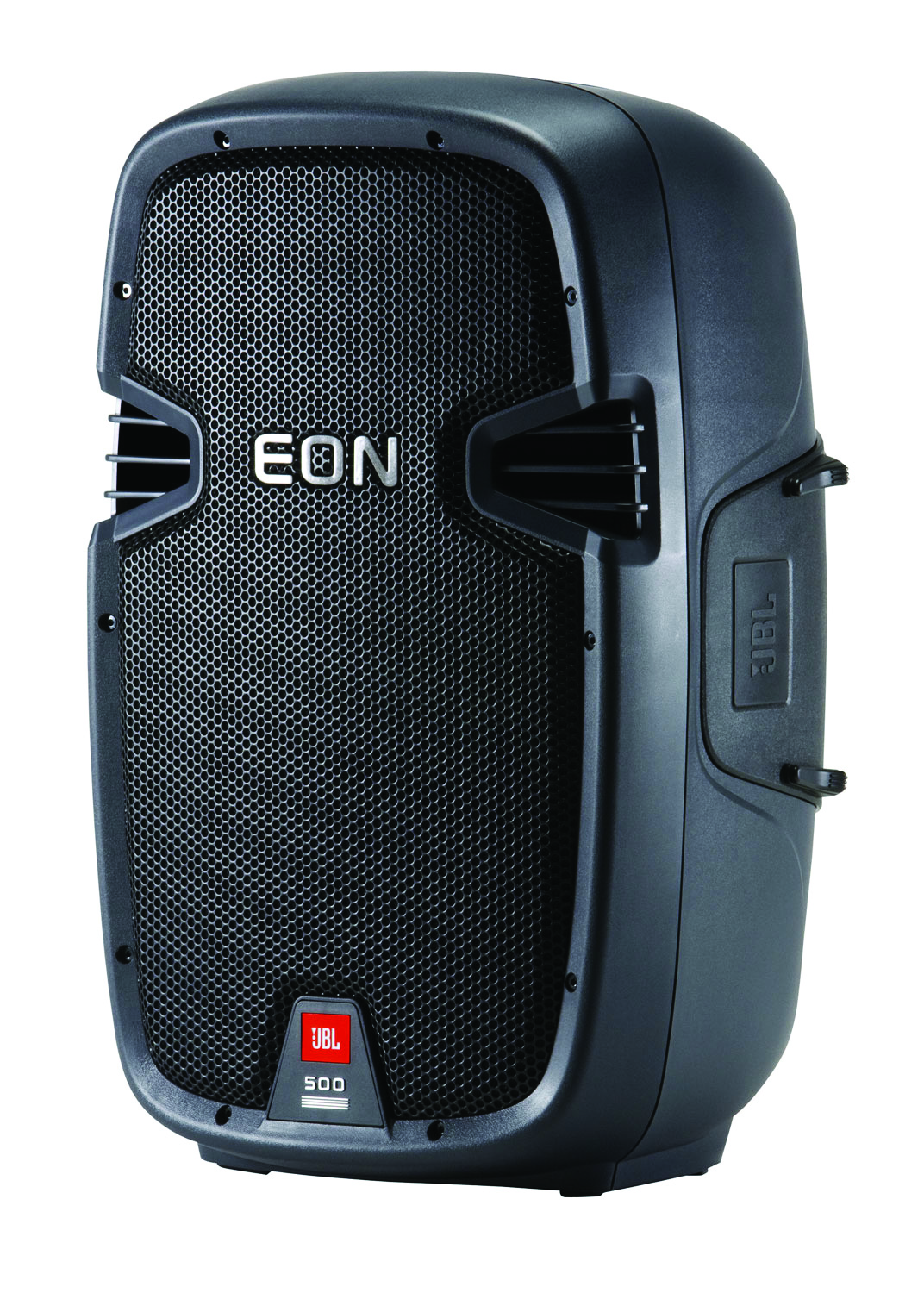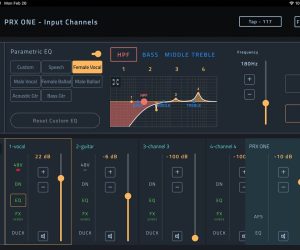
JBL EON 500 Series
The plastic box that started a craze has a new heir apparent.
I’m pretty fussy about my sound – as you might expect from someone who writes for this magazine. Up until a few years ago, even to the smallest of live gigs, I’d drag out at least one half of an active, double three-way PA. This included some mini-W sub bins loaded with 15-inch drivers powered by an ancient Jands M600 amplifier. I’m not a doof-doof freak; I just want that nice, bottom-end presence in my acoustic guitar.
It was my chiropractor who finally said, “Go and buy some powered speakers or I’m going to buy a new BMW at your expense.” So I went and purchased three JBL EON15 G2s (a pair for FOH and the third for foldback) and I’ve never looked back. I love ’em. For the record, I attacked my sub bins with a sharp saw and a screw gun, turning them into something lighter and more efficient, and they still get a run when they’re needed, but thanks to the EONs I have a stack of outboard gear rusting in the shed and my personal PA is truly portable and sounds great.
Which I figured made me eminently qualified to check out the new range of EONs, the 500 Series. The obvious question was always going to be, if it ain’t broke why have they fixed it? Did JBL simply repackage an existing product or has it re-invented the EON wheel?
500 FLAVOUR
The 500 Series comes in three flavours: the 510, 515 and 518S models. Astute readers will pick up on the clues here. The 510 offers a 10-inch (254mm) low frequency driver while the 515 sports a 15-inch (380mm) driver. Both use the same JBL2414H one-inch neodymium compression driver for the highs. The 518S is a self-powered subwoofer with an 18-inch (460mm) driver.
At this point we could dive deeper into the specs, but bugger that. I couldn’t resist lining up the EON 515s alongside my G2s, feeding them an identical signal, and comparing the two. The result was surprising. The new EONs have been given a completely different voice and operating characteristics. It seems JBL has dared to seriously tinker with a successful formula. This did have me scuttling back to the data pages to see what the designers have done.
One interesting statistic – when comparing the 515 with the older model G2 – is that the EONs have been put on a diet even Oprah would envy. The 515 has shed almost seven kilos, down to 14.8kg – nearly a third of the G2’s 21 kilos. This has been achieved by using entirely new neodymium drivers for both high and low frequency speakers, and powering them with Crown Class-D amps.
Physically the enclosures are roughly the same size, but gone is the angular, foldback wedge-like appearance, which admittedly was an absolute bastard to fit into a truck pack. As you can see from the picture, the 500s are a more traditional speaker shape with a full-length grille protecting both drivers, and all the corners are rounded including the rear section. Face down, it’s kind of like a loaf of bread… all right, a big, grey plastic loaf of bread – I’m sure you get the idea.
Full-sized carry handles with rubber grips on both sides and the top are an added bonus, too. To use the EONs as a monitor wedge they now lie on their side, rather than proud, upright and rather conspicuous like the G2. All the connections, switches and controls now sit snugly in a recessed panel at the centre of the speaker’s rear section, rather than on the outer edges, which offers them far more protection.
“Okay, okay…” you’re saying. “Enough of the knobs and handles. What’s that difference in the voice?”
The designers have significantly softened the high frequency delivery creating a more balanced, hi-fi type of sound rather than the bright, horn-flare-in-your-ear effect that many powered speakers (including the G2s) are guilty of – at least from close range. The word ‘mellow’ even comes to mind. Is this good? It’s true that while a nice-sounding cabinet is a big plus, some folks will argue there are definitely times when a super-efficient HF driver will save the day. Well, the 500’s are easier on the ear, but they can be asked to cut through when you need it.
JBL has also done away with the two-band EQ that had ±15dB of high and low shelving adjustment, and replaced it with a three-way switch giving you a Cut, Flat or Boost selection. The Boost setting has +3.5dB of LF at 200Hz and +2.5dB of HF at 4kHz. The Cut is a 120Hz roll-off. For me, the decision to remove what had previously been a very handy tweaking facility is an unfortunate one. The Boost has little impact apart from acting like a sort of ‘loudness’ switch at very low volumes, and neither one offers much finesse.
Another change is the input circuitry. You have to drive the new EONs harder it would seem. This isn’t a problem, however, except when mixing and matching the new EONs with older G2s, which many production companies will inevitably do. Other features from the G2 are still there. Microphone or line-level remains switchable and the output to daisy-chain extra speakers is either an unaffected ‘loop’ feed or a ‘mix’ of the speaker’s settings. There are three inputs, one an XLR and the other two balanced TRS so you can, for example, have a microphone and a stereo music source all connected at the same time. The EON has always been very versatile as either a PA component or a ‘speaker on a stick’ portable loudspeaker, and the new 500 series is no exception.
THE 10-INCH 500
Dropping down a step, the 510 is a Mini-me of the 515 with the exception that it only has two inputs. Rated at 280W (continuous) as against the 515’s 450W, it offers an impressive performance as a top box, particularly paired with the 518S. As a monitor speaker however, the smaller bass driver starts to show its limitations and things can get somewhat harsh when pushed.
THE SUB
The 518S sub bin struck me as a bit of a ‘stealth’ woofer. You turn it on, turn it up… and wonder if it’s working properly. Go for a walk among the audience, however, and you’ll notice that anyone with a stomach complaint is heading for the restrooms. The built-in crossover point is a fixed 120Hz – I would have liked some adjustment down to maybe 100Hz – and the delivery is a smooth, rich kind of bass that fills a space without being ostentatious about it. With 500 Watts of continuous power on offer, the 518S can do plenty of work, but a big, nasty kick drum in a larger room might be pushing your luck.
At 29.5kg the 518S is a comfortable lift, if you can get your arms around the damned thing. Otherwise it’s an easy two-person load. The inputs have a 120Hz HPF for matching with the 510 or 515. There’s also a polarity shift. Notice I say ‘inputs’? There are two for accepting a stereo feed, which adds a nice touch.
NEW-AGE EON
The new 500 series EONs are exactly that, a whole new product. Unlike what I’ve done here for the purposes of this review, the new 500 series JBLs really should be judged on their own merits, rather than compared slavishly to the G2 generation. You obviously can’t ignore JBL’s long heritage in developing this kind of speaker, so at the same time the comparison must be made. But the mellower 500 series EON should be regarded independently of its predecessor. Also, there’s a myth that needs dispelling: that any good powered speaker will sound brilliant just by plugging it in. As with any PA setup, you still have to do your homework with the 500 series to discover how to achieve optimum performance out of the cabinets on the night. No PA is hoisted into the air sounding perfect.
Still, the basic components you start with here are very good. The 515 is light, powerful and offers a pleasant, well-balanced sound that is superior to many of the powered cabinets available, and the 510 punches well above its class. Combine either of these two with the 518S and you’ve got a formidable, very portable PA system ideal for small bands, duos and DJs.
One last point. Like the G2, the co-polymer cabinets are tough indeed, but they scratch easily and any marks are there to stay. If you like to keep your new speakers in mint condition you should budget for the custom-built padded carry-bags. Only problem is, they don’t exist yet, but they’ll be worth geting when they surface.

















RESPONSES